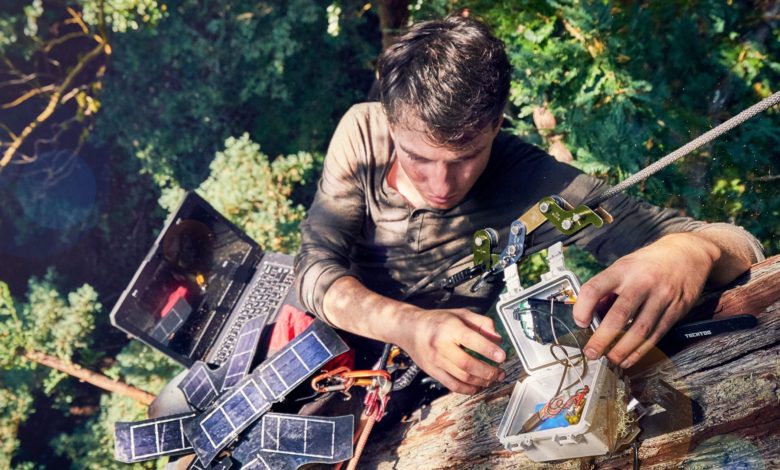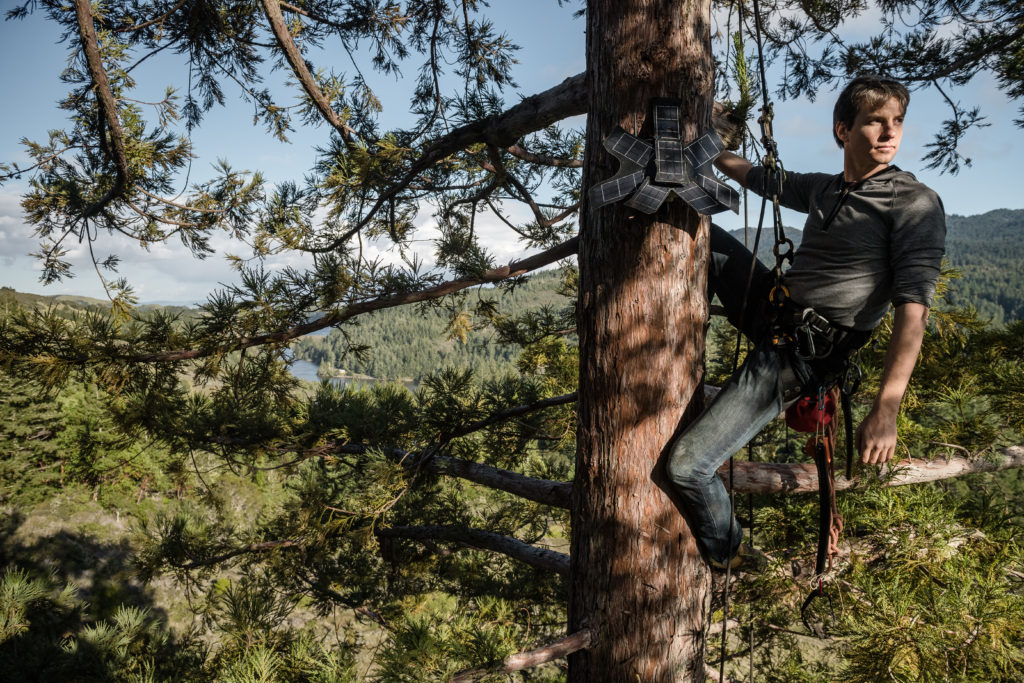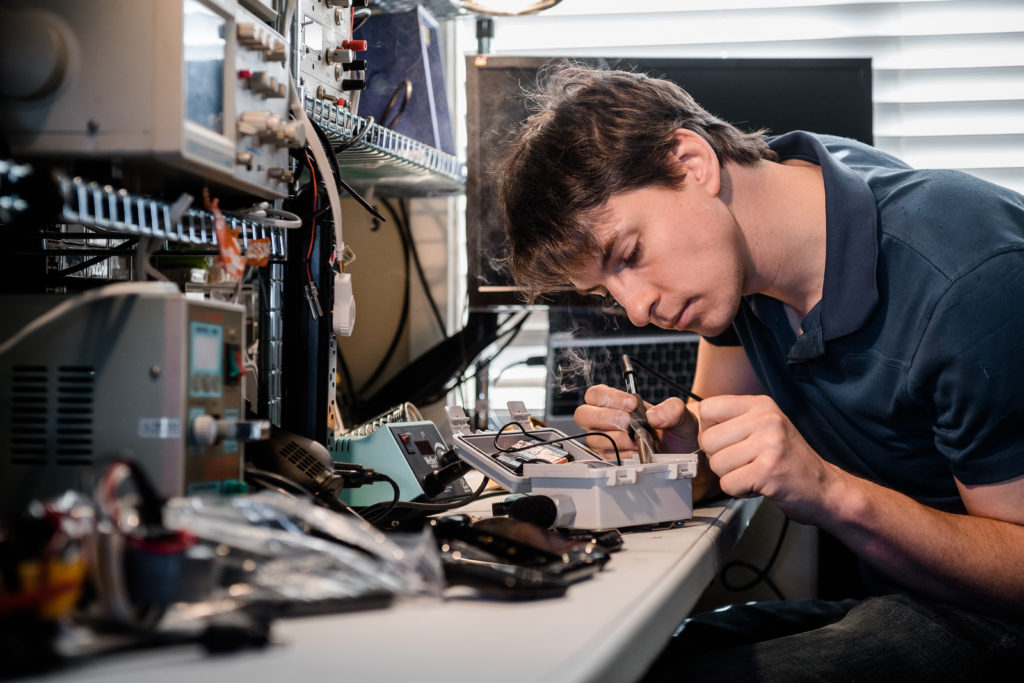
Rainforest connection installs AI into the forest by upcycling old cell phones to create solar-paneled units. Once installed into trees, the trackers use AI to listen out for illegal loggers and monitor biodiversity.
Who are Rainforest Connection
Rainforest connection’s success lies in the use of recycled technology, AI analysis, and collaboration with local communities to listen to the whispers and the secrets of the forest.
In 2011 on a visit to a gibbon reserve in Indonesia, rainforest connection’s founder and CEO Topher White was struck by the environmental struggles that the local community faced, inspired by the sounds of the forest.
In the province of West Sumatra Indonesia, illegal logging was a major problem. The lush and beautiful forests were threatened by continuous amounts of illegal deforesting and residents struggled to protect and police such a vast area with nothing but fences and patrollers.
Topher White set out on a mission to utilise the sounds of the forest, recording bioacoustics, and using AI to unpack and decipher the noises of the environment. Once he removed the chirping of the birds, the calls of monkeys, and the general hustle and bustle of forest life, what was left was an almost constant sound of a chainsaw.
The Guardians of the forest
Topher White was struck by the resounding issues of illegal loggers upon his visit to Indonesia. One of the primary causes of climate change is illegal deforestation and is a gateway to clearing huge areas of land. It’s estimated that 90% of tropical rainforest logging, is in fact illegal.
Topher White had the idea to create a track and alert system that would be installed in the living forest. Using your old cell phones he designed a device that would not only power itself with solar panels, but would be constantly listening to, and creating audio-acoustics of the sounds of the forest.

Sound was unarguably the most effective use of tracking as it’s qualities allow for automatic detection. Speaking to CEO Topher White, he said that “sound was the best way to detect threats in the forest because it really travels through. You can set up a sensor in one guardian and hear a km away”.
Topher successfully had installed a working alert system, that used AI to isolate the constant stream of sounds, identify audio’s such as chainsaw’s and motor vehicles, and pin-point it’s the exact destination.
The presence and immediacy of the RFCx monitoring system are where its success roots, with the goal being to catch logging trucks on the way in as opposed to on the way out.
This is not to say the project did not have to overcome many obstacles. Having a programmatic tech-system embedded into a living forest presents some difficulties. Getting enough sunlight to power the units was a challenge, as well as ensuring the phone signal was active within the areas of coverage, and having people within the community to respond.
Detecting illegal loggers is only as useful as having people at ground level to go and stop it. But what emerged was a pattern that showed illegal loggers were not daring to return after being caught in the act once or twice.
The RFCx monitoring system to prevent illegal loggers was just the beginning of the story.
The Cloud Based Data-base
Rainforest Connection is now monitoring bio-acoustics in five different countries, with examples such as Peru, Brazil, and Ecuador.
Every Guardian you put out in these locations is saving an endless timeline of audio that is taking place in the forest.
The cloud-based database is an initiative Topher has set out to build an interface that allows people to query, dive in, and dissect the vast amounts of audio data.
Rainforest connection have their own team of scientists who are now using the bio-acoustics to monitor and map eco-systems. But Topher wants to lower the bar and make this data available for anyone to use, not just experts in the field.
Topher says “we want to make these archives of information available to people, not just in scientifically relevant ways but to build tools for anybody to access this”.
Through using AI techniques, the audio-data can be used to zoom in and out of time scales, to isolate specific sounds and to listen to small changes in the forest. An interface that would allow this data to be accessible to scientists through to birdwatchers, would open up a platform of discoveries.
Biodiversity monitoring through AI
Installation of a Guardian is much like entwining a programmatic motor system into the nervous system of the forest, as Topher describes. Whilst this has allowed for the prevention of illegal logging and animal poaching, more recently Rainforest connection has been exploring the advantages of Biodiversity monitoring.
The area of Tech conservation is a developing area, and Topher White is paving the way for the potential of monitoring species, populations, and biodiversity through his software.

These bioacoustics allow people to listen in on the conversations of the forest. This ability to listen to conversations of the animals means we can gain secondary information on a wide range of data.
The state-of-the-art tracking of animals has always in the past been through looking at resources such as scat. More recently detection has been through camera traps, but that’s assuming that the animal will walk in front of the camera.
When tracking a species such as a tiger or a jaguar, the animals themselves makes extraordinarily little noise. But the other animals in the perimeter will most likely be talking about it, and it is through harnessing these sounds that eco-systems can be mapped.
In the AI analysis of bioacoustics, presented on an accessible interface, it will be made possible for anyone, anywhere to tune into these soundscapes.
The tracking systems lodged high up in the trees and the RFCx monitoring system is leading the way in an ethical fight against environmental matters. Acting as metaphorical weapons in the war against illegal logging, poaching and climate change these devices also offer assistance and collaboration with local communities, whose involvement in the projects is essential.
You can learn more about Rainforest connection by checking out their website.




